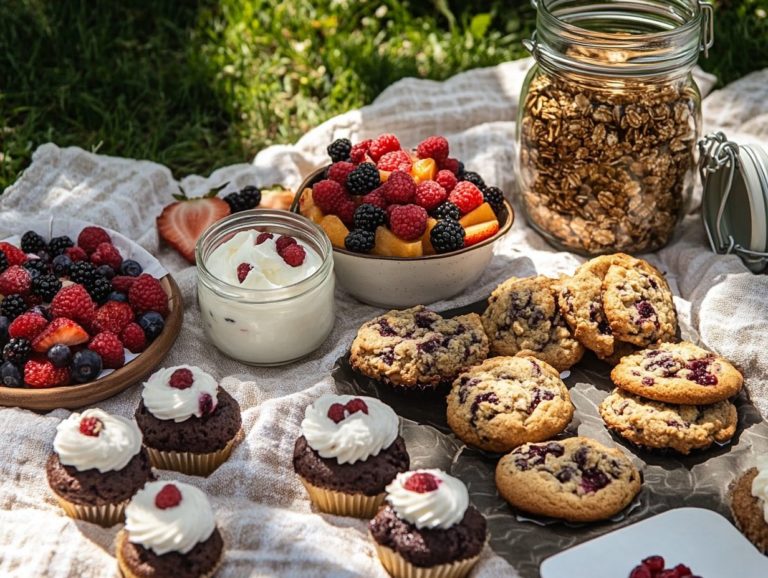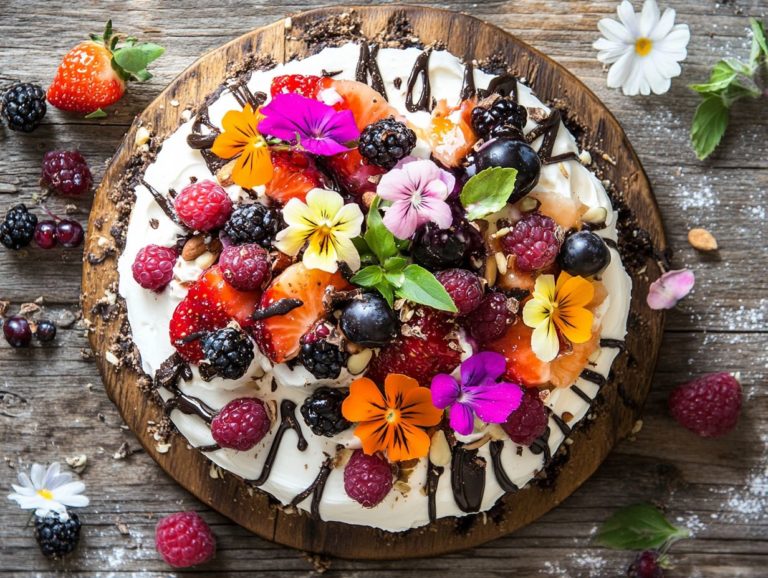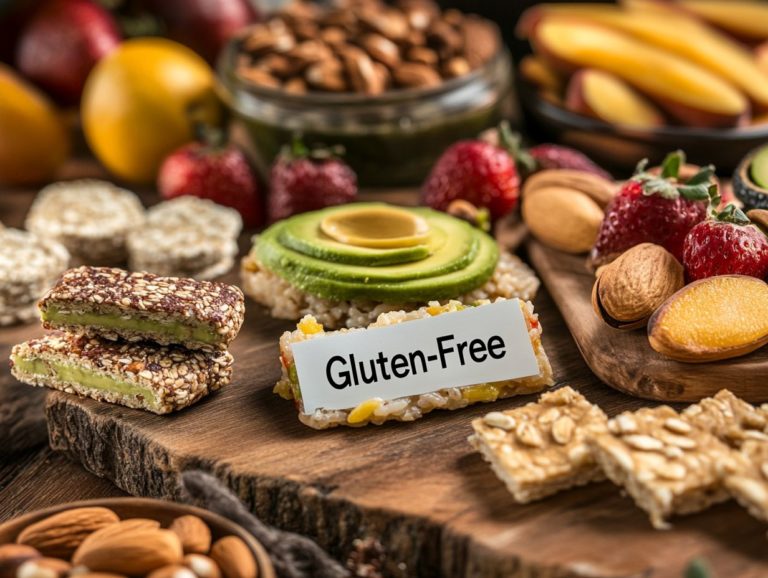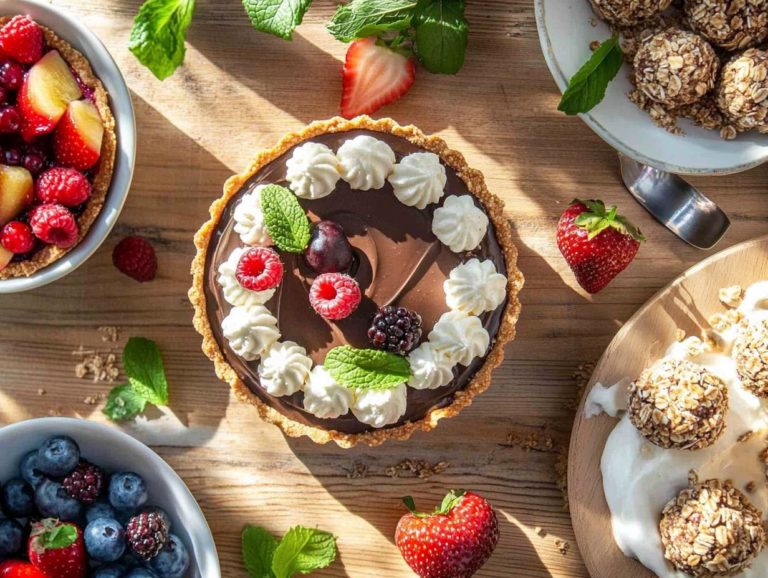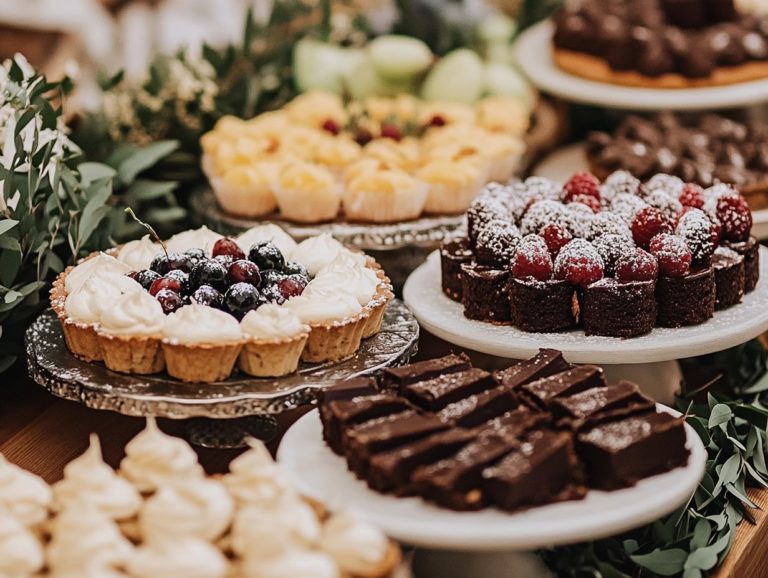Exploring the Benefits of Gluten-Free Desserts
Contents
- Introduction
- Key Takeaways:
- Why Choose Gluten-Free Desserts?
- What Are the Alternatives for Gluten in Desserts?
- Almond Flour
- Coconut Flour
- 3. Oat Flour
- 4. Buckwheat Flour
- 5. Quinoa Flour
- What Are the Health Benefits of Gluten-Free Desserts?
- How to Make Gluten-Free Desserts at Home?
- What Are Some Delicious Gluten-Free Dessert Recipes?
- 1. Flourless Chocolate Cake
- 2. Almond Butter Cookies
- 3. Banana Oatmeal Muffins
- 4. Coconut Flour Brownies
- 5. Quinoa Chocolate Chip Cookies
- Frequently Asked Questions
- What are the benefits of gluten-free desserts?
- Are gluten-free desserts suitable for people with celiac disease?
- Do gluten-free desserts taste different from traditional desserts?
- Can gluten-free desserts still be indulgent and decadent?
- Are gluten-free desserts only for those with dietary restrictions?
- Can gluten-free desserts be made at home?
Introduction
In recent years, gluten-free desserts have surged in popularity, captivating not only those with celiac disease or gluten sensitivity but also health-conscious individuals on the lookout for delectable alternatives. Get ready to explore delicious gluten-free recipes that will excite your taste buds! The rise of gluten-free products in the market has addressed increasing consumer demand and dietary restrictions.
This article reveals the compelling reasons to embrace gluten-free treats, from their healthier ingredients to their potential for aiding in weight management. You ll discover a variety of alternative flours, learn about their health benefits, and receive expert tips for crafting mouthwatering gluten-free desserts right in your own kitchen.
Prepare to indulge in delightful recipes that demonstrate how dessert can be both irresistibly tasty and wonderfully nourishing! From gluten-free cookies to peanut butter and chocolate treats, the possibilities are endless. Try these recipes today and discover the joy of gluten-free desserts that everyone will love!
Key Takeaways:

- Opting for gluten-free desserts can benefit those with celiac disease or gluten sensitivity, promoting better digestion and overall health.
- Substituting traditional flours with alternatives like almond, coconut, rice, and quinoa flour can create delicious and healthier gluten-free desserts.
- Baking your own gluten-free desserts at home can be simple with easy ingredient swaps and helpful tips, and can also aid in weight management and increased energy levels.
Why Choose Gluten-Free Desserts?
Opting for gluten-free desserts, like those from MyGFBakery or Bean Bag Bakery, is a vital choice for anyone navigating gluten sensitivity or celiac disease. These delightful treats are made with alternative flours such as almond, rice, and quinoa flour, offering not just a scrumptious indulgence but also notable health advantages.
They support digestive health, assist in weight management, and help reduce inflammation all essential for your overall well-being.
The expanding market for gluten-free products highlights a rising consumer desire for delicious and safe dessert options that cater to a variety of dietary needs and dietary restrictions. This market growth is driven by product innovation and consumer demand for better gluten-free ingredients.
1. Celiac Disease and Gluten Sensitivity
According to Medical News Today, celiac disease is an autoimmune disorder that affects you whenever gluten makes its way into your diet, leading to significant digestive issues and nutritional deficiencies. On a related note, you might experience gluten sensitivity, which can trigger discomfort and Irritable Bowel Syndrome (IBS) symptoms even if you haven t been officially diagnosed with celiac disease but prefer to steer clear of gluten for health reasons.
Both conditions underscore the body s adverse reactions to gluten, revealing symptoms such as bloating, diarrhea, fatigue, and skin rashes. This discomfort often pushes individuals like you to embrace a strict gluten-free lifestyle necessary, yes, but it can also usher in nutritional challenges, especially if your celiac disease diagnosis is recent.
It s essential to recognize that avoiding gluten doesn t automatically translate into a well-balanced diet. You need to be proactive about replacing gluten-containing foods with nutritious alternatives; otherwise, you risk falling short on vital B vitamins, iron, and fiber. With proper management and guidance, you can navigate these challenges, ensuring you maintain your health while following a gluten-free regimen.
2. Healthier Ingredients
Gluten-free desserts invite you into a world of healthier choices. They feature anti-inflammatory ingredients and alternative flours like almond flour, quinoa flour, and coconut flour.
These flours elevate flavor and offer tempting health benefits. They are nutrient-dense and have a lower glycemic index than traditional wheat flour, making them great for blood sugar management.
Incorporating flaxseed and chia seeds adds a delightful crunch while infusing your treats with omega-3 fatty acids, promoting heart health and reducing inflammation.
When it comes to gluten-free cookies, flavors like dark chocolate chip and snickerdoodle tantalize your taste buds. Natural sweeteners like honey or maple syrup further enhance these recipes, making gluten-free indulgence delicious and nutritious.
3. Weight Management
A gluten-free diet is your secret weapon for effective weight management. It boosts energy levels and is beneficial for those with gluten sensitivity or celiac disease.
When you eliminate gluten-containing foods, you often replace them with nutrient-rich alternatives. This shift enhances satiety and curbs cravings, helping you shed excess pounds while feeling more vibrant.
Many find improved cognitive function and a stable mood from a diet rich in whole foods packed with essential vitamins and minerals. Avoiding gluten can reduce inflammation, a key factor in maintaining a healthy metabolism.
As your energy levels rise, physical activity becomes enjoyable and sustainable. This newfound enthusiasm for movement supports your weight management goals.
What Are the Alternatives for Gluten in Desserts?
If you’re searching for indulgent gluten-free desserts, a variety of alternative flours awaits your exploration. You can easily swap traditional wheat flour.
With options like almond flour, coconut flour, and quinoa flour, you can maintain the delightful taste and texture of your favorite treats. Embrace these innovative choices to elevate your baking game while catering to dietary preferences.
Almond Flour
Almond flour is a popular gluten-free alternative. It adds a rich flavor and moist texture to desserts.
This finely ground nut flour brings delightful nuttiness and is packed with healthy fats, protein, and essential nutrients.
Picture yourself whipping up delicious almond macaroons or soft chocolate chip cookies. Almond flour lets you explore many recipes, from fluffy pancakes to rich gluten-free brownies.
Coconut Flour

Coconut flour is an excellent gluten-free option. It’s rich in fiber and healthy fats, making it a nutritious choice for bakers.
This versatile flour adds subtle sweetness and rich flavor, enhancing many baked goods.
Picture yourself enjoying moist muffins and delightful cookies. Coconut flour’s low carbohydrate content is appealing for low-carb and ketogenic diets.
It’s also packed with beneficial nutrients, including medium-chain triglycerides (MCTs), which can support weight management and heart health.
Whether you’re making savory dishes like coconut flour pizza crusts or sweet treats like brownies, its unique texture and flavor provide a wonderful alternative for those with gluten sensitivities.
3. Oat Flour
Oat flour stands out as a versatile gluten-free alternative, perfect for anyone looking to avoid gluten a protein found in wheat and other grains. It brings a mild flavor to the table, making it an ideal choice for a variety of gluten-free desserts while also delivering impressive health benefits.
Its naturally sweet and subtly nutty profile enhances the flavor of your baked goods without overpowering other ingredients. Packed with fiber, protein, and essential vitamins, oat flour bridges nutritional gaps often found in gluten-free diets. It’s a valuable source of magnesium and antioxidants, especially helpful for those looking to boost their nutrient intake.
Whether you re whipping up cookies, pancakes, brownies, or cakes, oat flour can be effortlessly woven into your dessert recipes. Enjoying these delicious, healthier treats is a delight for everyone!
4. Buckwheat Flour
Buckwheat flour emerges as a nutrient-rich, gluten-free choice that introduces a distinctive flavor to your desserts. It boasts a range of health benefits, including impressive antioxidant levels, making it a fantastic addition for anyone with gluten sensitivities.
This flour, derived from the seeds of the buckwheat plant which is completely unrelated to wheat offers an earthy, nutty taste that enhances both sweet and rich ingredients. Want to try something new in your baking? Buckwheat flour might just be the twist you need!
Imagine using it in pancakes or brownies, creating delightful treats that also deliver extra nutrition. With its high protein and fiber content, buckwheat flour provides a satisfying texture in baked goods, presenting a wholesome alternative to conventional flours. It’s especially helpful for those with gluten sensitivities or celiac disease.
Many bakers find joy in experimenting with buckwheat flour in cookies and muffins, where its unique flavor elevates classic recipes. Bakeries like MyGFBakery and Bean Bag Bakery in the UK offer a variety of delicious gluten-free products that cater to different dietary restrictions.
5. Quinoa Flour
Quinoa flour stands out as a remarkable gluten-free alternative, brimming with protein and making it an exceptional choice for enhancing the nutritional profile of your gluten-free cookies and other delightful desserts. Its versatility makes it a staple in the growing market for gluten-free products.
By incorporating quinoa flour into your baking repertoire, you can elevate your protein intake while introducing a unique, nutty flavor that beautifully complements a variety of sweet treats. This flour is perfect for crafting recipes such as fudgy brownies, light and fluffy pancakes, or even sumptuous muffins all while providing a hearty texture and delicious taste. It’s particularly beneficial for those managing gluten sensitivity, celiac disease, or other gluten-related issues.
For a delightful twist, why not try your hand at quinoa flour chocolate chip cookies or airy quinoa flour pancakes adorned with fresh fruits? These creations will not only satisfy your sweet cravings but also offer essential nutrients, making them a wholesome addition to your diet. With the increasing market growth and product innovation in gluten-free baking, you have endless possibilities to explore!
What Are the Health Benefits of Gluten-Free Desserts?
Gluten-free desserts present a wealth of health benefits, including improved digestion, heightened energy levels, and a decreased risk of nutritional deficiencies. These advantages are especially important for those who need to avoid gluten due to celiac disease, gluten sensitivity, or other gluten-related conditions.
By integrating anti-inflammatory ingredients like almond flour and rice flour, these delectable treats play a significant role in promoting your overall health and well-being.
1. Improved Digestion
One of the primary benefits of enjoying gluten-free desserts is the improvement in digestion. This is particularly crucial for those struggling with gluten sensitivity, celiac disease, or IBS symptoms. These delightful treats can help alleviate discomfort and gastrointestinal issues often linked to gluten consumption.
By choosing gluten-free options, you can savor sweet delights without the looming threat of painful bloating or cramps. Many gluten-free recipes use alternative flours, such as almond or coconut flour, which offer essential nutrients and also contain beneficial fats and fibers that actively support gut health. This is advantageous for those following a gluten-free diet or experiencing gluten-related digestive issues.
Incorporating ingredients like honey, chia seeds, and probiotic-rich yogurt can further reduce inflammation, promote a balanced gut microbiome (the community of bacteria in your intestines), and enhance overall digestive wellness. These desserts allow you to indulge your sweet tooth without compromising your health, making them a delicious choice for anyone affected by gluten-related issues. According to Medical News Today, such ingredients can actively support weight management and digestive health.
2. Increased Energy Levels
Opting for gluten-free desserts provides a remarkable boost to your energy levels! These treats offer essential nutrients while steering clear of gluten, which can lead to fatigue and other unpleasant symptoms, especially for those with celiac disease or gluten sensitivity.
This dietary choice is particularly beneficial for individuals sensitive to gluten, who often feel sluggish and unwell after consuming it. By focusing on nutrient-rich ingredients like almond flour, coconut sugar, and fresh fruits, gluten-free desserts can effectively counteract these negative effects.
These wholesome alternatives not only satisfy your sweet cravings but also provide your body with vital vitamins, minerals, and healthy fats that contribute to stable energy levels. Without gluten, your digestive system can operate at its best, allowing you to maintain your vitality throughout the day without those frustrating energy dips typically linked to gluten-laden foods. This is particularly vital for those diagnosed with celiac disease or other gluten-related health concerns.
3. Better Nutrient Absorption

Gluten-free desserts can significantly enhance your nutrient absorption by removing gluten from your diet. This is especially beneficial for those with celiac disease, gluten sensitivity, or other gluten-related conditions, allowing for improved overall health and a lower risk of nutritional deficiencies.
By prioritizing balanced, nutrient-dense ingredients, these treats can be both indulgent and beneficial. Incorporating whole grains like almond flour or coconut flour delivers essential nutrients and fiber while elevating the taste and texture of your desserts. Opting for natural sweeteners such as honey or maple syrup provides vitamins and minerals without the drawbacks of refined sugars.
This thoughtful approach to gluten-free baking ensures that you can savor delightful treats while nourishing your body with the vital nutrients it needs to thrive. Selecting the right ingredients can make a remarkable difference in your health journey, reducing risks associated with nutritional deficiencies.
Try gluten-free desserts today and experience their amazing health benefits! Explore delicious recipes that can enhance your well-being.
How to Make Gluten-Free Desserts at Home?
Baking gluten-free treats at home can be a delightful adventure. With a few simple swaps and tips, you can create desserts that everyone will love!
Get ready to impress your friends with effortless gluten-free desserts! By making easy substitutions with gluten-free ingredients, you ensure that everyone can indulge in delightful treats without sacrificing flavor or texture.
With a dash of creativity and the innovative use of alternative flours like rice flour and almond flour, as well as gluten-free products, you can elevate ordinary recipes into extraordinary gluten-free delights.
1. Simple Swaps for Gluten-Free Ingredients
One of the simplest ways to create gluten-free desserts is by making straightforward ingredient swaps in traditional baking. For instance, consider replacing regular flour with gluten-free options like almond flour, rice flour, or coconut flour.
These alternatives cater to those with gluten sensitivities. They also enhance the flavor and texture of your baked goods in remarkable ways. Almond flour, for example, imparts a delightful nutty taste and moisture that elevates cakes and cookies. Meanwhile, coconut flour introduces a unique sweetness that s hard to resist.
For an additional twist, try incorporating peanut butter or chocolate to further enrich your creations. Opting for natural sweeteners like honey or maple syrup in place of refined sugar improves the health profile of your desserts, offering essential nutrients and a lower glycemic index.
By exploring these alternatives, you can indulge in delicious treats that are gentler on the digestive system. This approach is particularly beneficial for those aiming to avoid gluten for health reasons.
2. Tips for Baking with Gluten-Free Flours
When you embark on baking with gluten-free flours, keep several essential tips in mind. For instance, blending different flours can greatly enhance the texture and moisture of your gluten-free desserts.
Consider experimenting with combinations like almond flour and coconut flour. This not only elevates the flavor but also creates a lighter, more delightful crumb. Pay careful attention to your ratios; using a 1:1 ratio of gluten-free flour to starch can often yield impressive results.
This method is frequently recommended in gluten-free baking guides and by health experts covering gluten avoidance strategies. Incorporating binders such as xanthan gum (a natural thickening agent) or psyllium husk (a plant-based fiber supplement) will significantly improve the structure and elasticity of your baked creations.
The importance of innovation in gluten-free products cannot be overstated; it paves the way for developing new recipes that not only mirror but often surpass traditional offerings. This creative approach allows you to explore a world of enticing and diverse options that everyone can savor.
From gluten-free cookies to elaborate cakes, the possibilities are endless for those seeking gluten-free desserts that align with their dietary restrictions.
What Are Some Delicious Gluten-Free Dessert Recipes?
You ll discover an array of exquisite gluten-free dessert recipes that cater to a wide range of tastes and preferences. Indulge in options like gluten-free cookies, cakes, and brownies that are not only satisfying but also come with an array of health benefits.
These recipes are particularly beneficial for those with celiac disease or other gluten-related diseases. Each recipe promises to delight your palate while keeping your dietary needs in mind.
Dive into these recipes today and discover the joy of gluten-free baking!
1. Flourless Chocolate Cake
Flourless chocolate cake is a rich and decadent gluten-free dessert that marries high-quality chocolate with eggs and sugar. This results in a moist and flavorful treat perfect for special occasions. It caters to those with gluten sensitivity, making it an ideal option for various dietary restrictions.
What truly makes this cake enticing is its harmonious blend of simple yet premium ingredients. It s an excellent choice for those seeking a lighter alternative without sacrificing flavor. The silky texture comes from the melted chocolate, while the eggs lend structure and protein, making it a satisfying option for various dietary preferences. This cake highlights new gluten-free baking ideas, ensuring that everyone can enjoy delicious desserts.
For an elevated experience, consider serving this cake with a dollop of freshly whipped cream or a scoop of vanilla ice cream, both beautifully complementing the chocolate. You can also experiment with variations, such as adding a hint of espresso or flavored extracts to elevate the cake’s complexity and cater to your discerning palate.
2. Almond Butter Cookies
Almond butter cookies are a delightful and nutritious gluten-free treat that you can savor. With their rich, nutty flavor derived from almond butter, these cookies offer a satisfying bite packed with healthy fats and protein. They re ideal for those following a gluten-free diet, providing a delicious way to meet specific dietary needs.
These cookies aren t just about indulgence; they also support a wholesome diet. Almond butter is an excellent source of vitamin E, magnesium, and fiber, making these cookies a more health-conscious dessert option.
Perfect for anyone embracing a gluten-free lifestyle or managing gluten sensitivity, they’re also remarkably easy to prepare. Filled with ingredients that help you feel full and energized, almond butter cookies strike the perfect balance between taste and nutrition. They are a must-have for health enthusiasts like you.
3. Banana Oatmeal Muffins

Banana oatmeal muffins present a wholesome gluten-free choice that beautifully marries ripe bananas with gluten-free oats. This combination results in a moist and flavorful breakfast or snack brimming with health benefits and aiding in weight management.
These muffins kickstart your day with delightful flavor. They are also an excellent source of dietary fiber, potassium, and essential nutrients, making them an ideal option for anyone seeking healthier alternatives that support digestive health. The natural sweetness of the bananas diminishes the need for added sugars, while the oats lend a satisfying texture that keeps you feeling full for longer.
If you have nut allergies, feel free to swap almond milk for a dairy-free alternative like coconut or soy milk. You can also use rice flour or quinoa flour for added texture and nutrition. If you re craving a touch of sweetness, a drizzle of honey or maple syrup can elevate the flavor without sacrificing their gluten-free status.
Get creative by adding nuts, seeds, or dried fruits for an extra nutritional boost.
4. Coconut Flour Brownies
Coconut flour brownies are a luxurious gluten-free dessert that delivers a fudgy, rich experience. They showcase coconut flour’s unique texture and flavor while serving as a healthier alternative to traditional recipes. These brownies, made with ingredients that help reduce inflammation in the body, contribute to better digestive health.
These brownies do more than just satisfy your sweet tooth; they re also loaded with nutritional benefits. Coconut flour is high in fiber and protein, aiding digestion and supporting muscle growth. When crafted with care, they provide a nourishing option for those who crave indulgence without sacrificing taste. You can incorporate natural sweeteners to reduce refined sugar intake, transforming these brownies into a guilt-free delight.
If you re gluten-sensitive, indulge in these moist creations alongside family and friends. Share the joy of a delicious homemade treat that everyone can enjoy!
Try these recipes today!
5. Quinoa Chocolate Chip Cookies
Quinoa chocolate chip cookies offer a nutritious, gluten-free dessert option that elevates your classic cookie experience by incorporating quinoa. This delightful ingredient adds a satisfying crunch and packs in extra protein.
Not only are these cookies a treat for your taste buds, but they also serve as a guilt-free alternative to traditional sweets. They aid in weight management and boost energy levels. These cookies let you indulge while adhering to gluten-free diets or simply seeking healthier snacking options.
By adding quinoa, renowned for its high protein content and important protein parts, you transform an ordinary cookie into a more balanced snack. This is ideal for those on a gluten-free diet or looking to reduce inflammation.
If you’re feeling adventurous, consider enhancing your cookies with nuts, seeds, or even dried fruits for a flavor explosion in every bite. These cookies pair beautifully with a glass of almond milk. For a delightful treat that you won’t want to miss, warm them up and serve with a scoop of dairy-free ice cream.
These options highlight the versatility of gluten-free products and the innovation in gluten-free desserts. You’ll satisfy your sweet tooth while promoting your well-being.
Frequently Asked Questions
What are the benefits of gluten-free desserts?
Gluten-free desserts offer a variety of benefits. They are a safe and delicious option for those with gluten intolerances or celiac disease. Additionally, they help in reducing IBS symptoms and avoiding gluten-related diseases.
These desserts can be a healthier alternative to traditional sweets, as they are often made with whole, natural ingredients and are lower in calories and sugar. This aligns with the growing market demand for gluten-free products and the push for product innovation in the gluten-free bakery market.
Are gluten-free desserts suitable for people with celiac disease?
Yes, gluten-free desserts are safe for people with celiac disease. They do not contain any gluten, which is a protein found in wheat, barley, and rye that can trigger adverse reactions in those with the disease. According to Medical News Today, gluten can cause significant health issues for those with gluten-related diseases.
Do gluten-free desserts taste different from traditional desserts?
Gluten-free desserts can have a slightly different taste and texture compared to traditional desserts. However, with the right ingredients and recipes, they can be just as delicious and satisfying. Using alternative flours like almond flour or peanut butter can elevate the flavor profile.
Can gluten-free desserts still be indulgent and decadent?
Absolutely! There are many decadent and indulgent gluten-free dessert options available, such as chocolate lava cakes, cheesecakes, and fruit tarts. These options highlight the product innovation in gluten-free diets. You don’t have to sacrifice taste or flavor when choosing gluten-free desserts.
Are gluten-free desserts only for those with dietary restrictions?
No, gluten-free desserts can be enjoyed by anyone, whether they have dietary restrictions or not. They offer a tasty and nutritious option for anyone looking to try something new or incorporate more natural, whole foods into their diet. This is especially beneficial for those looking to manage nutritional deficiencies.
Can gluten-free desserts be made at home?
Yes, there are plenty of gluten-free dessert recipes available online and in cookbooks that can be made at home. Websites like MyGFBakery and Bean Bag Bakery in the UK offer numerous recipes and gluten-free ingredients to help you create delicious treats.
With some basic ingredients and kitchen tools, you can easily whip up delicious and healthy gluten-free desserts in your own kitchen. This caters to those with dietary restrictions and enhances your culinary skills.

